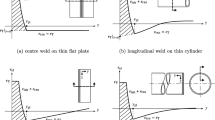Abstract
Experimental measurements are presented to demonstrate the longitudinal strain changes that occur when structural sections are welded. The measurements show that the final deformation in the upset zone can be as much as 35 percent more than the transient deformation on heating. The assumption in the Okerblom analysis that these two deformations are equal is discussed in view of the results.1 In addition, measured final deformations are compared to those predicted from this same analysis for a wide range of edge-welded rectangular bar sections.
Similar content being viewed by others
Abbreviations
- C :
-
curvature (m−1)
- F :
-
bar cross-sectional area (m2)
- F s :
-
equivalent upset area (m2)
- I :
-
current (amps)
- J :
-
moment of inertia (m4)
- Q :
-
heat-input rate (J/s)
- T :
-
temperature (°C)
- [T(y)] max :
-
maximum temperature reached by coordinate positiony (°C)
- V :
-
voltage (volts)
- c ϱ:
-
volumetric heat capacity (J/m3 °C)
- h :
-
bar width (m)
- l :
-
bar length (m)
- t :
-
bar thickness (m)
- v :
-
welding speed (m/s)
- w :
-
isotherm width (m)
- y :
-
coordinate distance perpendicular to the direction of heat-source travel
- z :
-
coordinate distance across the bar cross section
- z 1 :
-
distance alongz from the bar center of gravity to the centroid of the thermal deformations (m)
- (z 1) H :
-
distance to centroid of thermal deformations on heating (m)
- (z 1) R :
-
distance to centroid of residual thermal deformations (m)
- α:
-
coefficient of thermal expansion (°C−1)
- δ m :
-
maximum deflection (m)
- Δl :
-
contraction due to welding (m)
- Δ:
-
deformation
- △ R :
-
residual deformation in the upset zone
- △ y :
-
deformation at coordinate position y
- Δc.g. :
-
contraction strain at the center of gravity
- △ RT :
-
maximum residual tensile strain on the remote edge
- △ TC :
-
maximum transient compressive strain on the remote edge
- ∈ y :
-
yield strain
- η:
-
thermal efficiency
- ∑λ F :
-
sum of thermal deformations (Okerblom limits) (m2)
- ∑λ F ' :
-
sum of thermal deformations (modified limits) (m2)
- (∑λ F ) H :
-
sum of thermal deformations on heating (m2)
- (∑λ F ) R{ :
-
sum of residual thermal deformations (m2)
References
Okerblom, N.O., “The Calculation of Deformations of Welded Metal Structures,” Mashgiz Publication, Moscow (1955), Translated by Her Majesty's Stationery Office, London (1958).
Wan, Y.L., Bibby, M.J. and Goldak, J.A., “Structural Deflections Due to Welding,” Document X-896-78, Intnl. Inst. of Weld. (1978).
Wan, Y.L., Bibby, M.J. and Goldak, J.A., “Effect of Electrode and Base Metal Strength on Structural Deflections Due to Welding,” Document X-896-78, Intnl. Inst. of Weld. (1978).
Rosenthal, D., “The Theory of Moving Heat Sources and Its Application of Metal Treatment”,TRANS ASME,68,849–865 (1946).
Rykalin, N.N., “The Calculation of Thermal Processes in Welding,”Mashgiz Publication, Moscow (1951),Translated to English by Z. Paley, and C.M. Adams (1963).
Gray, T., Spence, J. andNorth, T., “Rational Welding Design,”London Butterworths Publication, London, 45–55 (1975).
McParlan, M. andGraville, B., “Hydrogen Cracking in Weld Metal,”Weld. J.,55,95s-102s (1976).
Author information
Authors and Affiliations
Rights and permissions
About this article
Cite this article
Wan, Y.L., Bibby, M.J. & Goldak, J.A. Transient longitudinal strain changes during welding. Experimental Mechanics 19, 259–264 (1979). https://doi.org/10.1007/BF02328655
Received:
Revised:
Issue Date:
DOI: https://doi.org/10.1007/BF02328655




